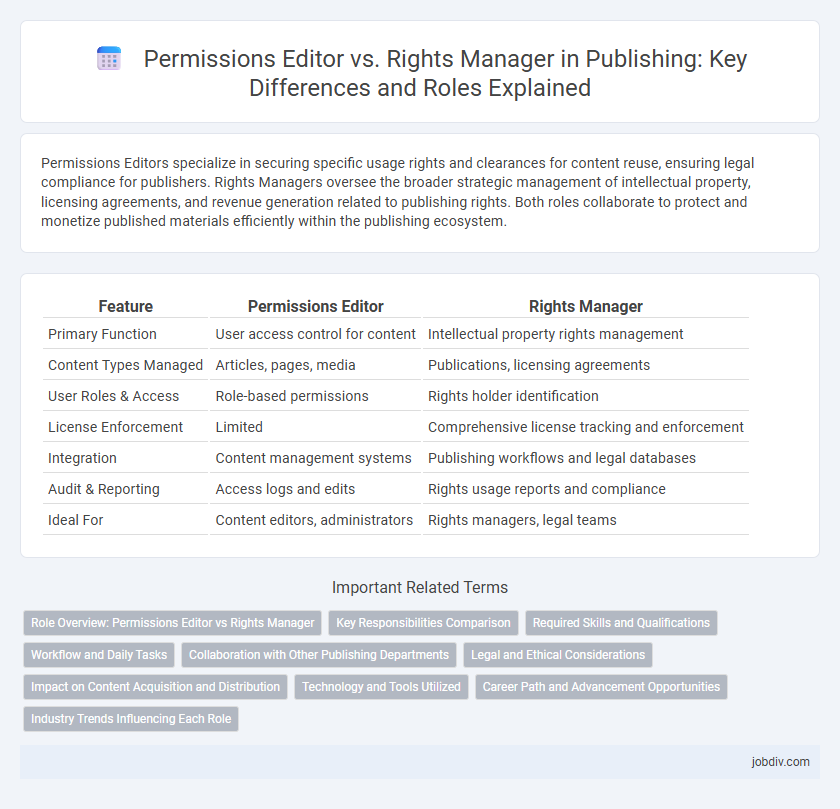Permissions Editors specialize in securing specific usage rights and clearances for content reuse, ensuring legal compliance for publishers. Rights Managers oversee the broader strategic management of intellectual property, licensing agreements, and revenue generation related to publishing rights. Both roles collaborate to protect and monetize published materials efficiently within the publishing ecosystem.
Table of Comparison
| Feature | Permissions Editor | Rights Manager |
|---|---|---|
| Primary Function | User access control for content | Intellectual property rights management |
| Content Types Managed | Articles, pages, media | Publications, licensing agreements |
| User Roles & Access | Role-based permissions | Rights holder identification |
| License Enforcement | Limited | Comprehensive license tracking and enforcement |
| Integration | Content management systems | Publishing workflows and legal databases |
| Audit & Reporting | Access logs and edits | Rights usage reports and compliance |
| Ideal For | Content editors, administrators | Rights managers, legal teams |
Role Overview: Permissions Editor vs Rights Manager
Permissions Editors in publishing oversee the authorization and clearance of content usage, ensuring all materials comply with copyright laws and internal policies. Rights Managers handle licensing negotiations, contract management, and the strategic monetization of intellectual property. Both roles collaborate to safeguard legal compliance while maximizing content value across distribution channels.
Key Responsibilities Comparison
Permissions Editors handle the acquisition and clearance of rights necessary for publication, ensuring compliance with copyright laws and securing licenses from rights holders. Rights Managers oversee broader intellectual property strategies, managing copyright registrations, licensing agreements, and the enforcement of usage rights to protect the publisher's content. Both roles coordinate to optimize legal and financial control over published works, but Permissions Editors focus primarily on permission clearance while Rights Managers concentrate on ongoing rights administration.
Required Skills and Qualifications
Permissions Editors require expertise in copyright law, meticulous attention to detail, and strong communication skills to negotiate and secure permissions for text, images, and multimedia content. Rights Managers must have a comprehensive understanding of intellectual property rights, licensing agreements, and contract management, along with proficiency in legal documentation and stakeholder negotiation. Both roles demand analytical thinking, familiarity with digital rights management systems, and the ability to navigate complex legal frameworks within the publishing industry.
Workflow and Daily Tasks
Permissions Editors primarily handle the clearance of content permissions and maintain communication with rights holders to ensure legal use in publishing workflows. Rights Managers focus on the broader scope of managing intellectual property rights, negotiating licenses, and monitoring compliance across multiple platforms. Daily tasks for Permissions Editors include reviewing content requests and updating permissions databases, while Rights Managers engage in contract negotiations, rights valuations, and strategic rights management initiatives.
Collaboration with Other Publishing Departments
Permissions Editors coordinate closely with legal and editorial teams to secure and document necessary usage licenses, ensuring content compliance across publishing projects. Rights Managers collaborate with marketing and distribution departments to optimize licensing strategies and maximize revenue from intellectual property assets. Both roles require seamless interdepartmental communication to streamline workflow and uphold copyright standards within publishing operations.
Legal and Ethical Considerations
Permissions Editors focus on securing necessary approvals for content use, ensuring compliance with copyright laws and proper attribution, while Rights Managers oversee the broader legal framework, managing licensing agreements and monitoring usage to prevent infringement. Legal and ethical considerations in publishing demand that Permissions Editors verify third-party content permissions, whereas Rights Managers enforce adherence to intellectual property rights and handle disputes. Both roles collaborate to uphold publishing integrity, protect authors' rights, and mitigate legal risks related to content distribution.
Impact on Content Acquisition and Distribution
Permissions Editors streamline content acquisition by efficiently securing usage rights and managing licensing agreements, which accelerates the publishing workflow. Rights Managers oversee the broader scope of intellectual property, ensuring compliance with copyright laws and optimizing distribution channels to maximize revenue. This division of responsibilities enhances content acquisition speed while safeguarding legal and financial interests throughout the distribution process.
Technology and Tools Utilized
Permissions Editors leverage integrated digital rights management (DRM) platforms and content tracking software to streamline the approval and licensing processes, enhancing efficiency in handling copyright permissions. Rights Managers utilize advanced rights clearance databases, AI-based usage analytics, and automated contract management systems to monitor, enforce, and optimize the exploitation of intellectual property across multiple channels. Both roles increasingly adopt cloud-based collaboration tools and blockchain technology to ensure transparency, security, and accuracy in rights administration.
Career Path and Advancement Opportunities
Permissions Editors specialize in acquiring and managing content usage rights, which develops expertise in copyright law and contract negotiation, paving the way toward senior editorial or legal advisory roles within publishing. Rights Managers oversee broader intellectual property portfolios and licensing strategies, gaining strategic skills that facilitate advancement into director-level positions or executive roles in publishing rights and business development. Career progression in both paths benefits from mastering digital rights management and emerging media, increasing value in a competitive, evolving publishing industry.
Industry Trends Influencing Each Role
Permissions Editors increasingly leverage AI-driven metadata tools to streamline rights clearance workflows, aligning with industry trends prioritizing automation and scalability. Rights Managers focus on complex contract negotiations and global licensing, reflecting growing demand for international content distribution and digital rights monetization. Both roles adapt to evolving legal frameworks and digital platforms reshaping the publishing ecosystem.
Permissions Editor vs Rights Manager Infographic

 jobdiv.com
jobdiv.com